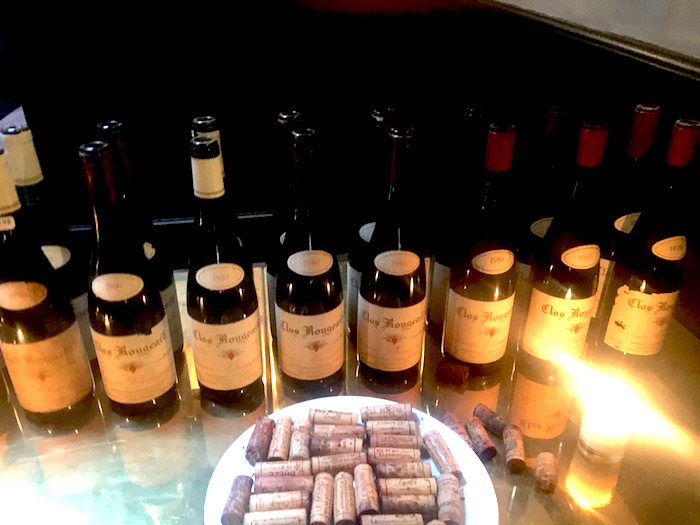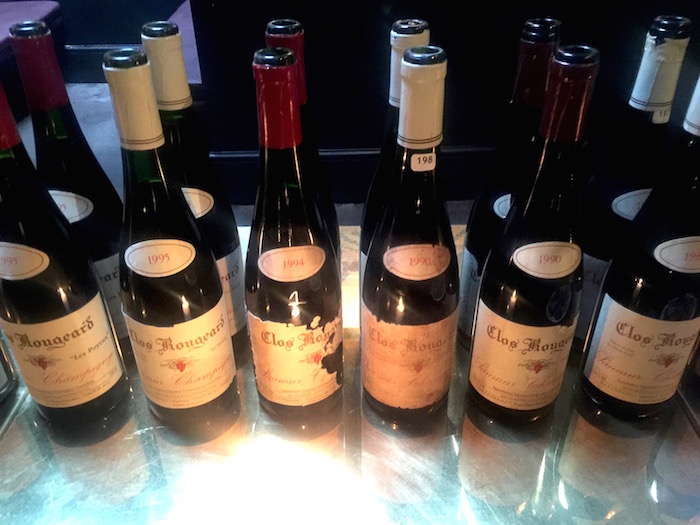by Wine Owners
Posted on 2022-10-13
Today the wine part of the Wine Owners team, as opposed to the tech team who provide our best-in-class software solutions, tasted wines from one of the great sub-sections of the Union of Grand Crus; it is called the Bordeaux Grands Crus Classés - to avoid confusion!
Wines offered came from 2018-2021 vintages. What was abundantly clear was that 2019 has reconfirmed itself as the best of modern vintages. Also, 2018 is not for the faint hearted, especially Montrose, and also that second wines offer a lot of drinking pleasure at a diddly squat fraction of grand vin prices. La Dame de Montrose excelled, as did La Croix de Canon. The unpronounceable Chateau d’Aiguilhe from the Cotes de Castillon performed well, as usual (apart from the ’21), and at £150 per 12 in bond for the 2019 is remarkable value. Chateau Canon reinforced its ‘polished’ status and was probably the most consistent.
There were some volatile samples of ‘21s, which we imagine not to be representative.
To my mind, the question is not what to buy but when to buy, if you haven’t already - 2019 should be in everybody’s cellars.
Chateaux represented:
Smith Haut Lafitte
Gazin
Vignobles Comtes Von Niepperg - d’Aiguilhe, Clos de l’Oratoire, Canon La Gaffeliere, La Mondotte
Canon
Rauzan Segla
Branaire Ducru
Pontet Canet
Montrose
Guiraud
For enormous pleasure and for a twist on sweet wines, readers should definitely embrace the current trend of lighter wines from the region. Fresher and less sweet wines from Sauternes were particularly well represented by the second wines of Chateau Guiraud and these will make a very stylish aperitif. The dry whites of Smith Haut Lafitte were superb, and are so often overlooked for more obvious alternatives, Burgundy normally, as are most dry white Bordeaux wines - in the U.K. at least.
Miles Davis October 11th 2022
by Wine Owners
Posted on 2020-01-27
By Miles Davis, 27th January 2020
Summary
Piedmont is on the up, the area and the wine. The region is extremely picturesque, and the food and wine scene is superb. Winemaking is better than ever with younger generations bursting through full of energy and enthusiasm and the wines are getting better and better. In my experience, they are becoming more approachable too. The natural acidities of the grapes and the soils can handle, if not benefit, from the warmer climate and there have been some very fine vintages in the recent past. In global terms, Piedmont is relatively undiscovered and comparative values to other great regions make for a compelling story – read on!
Background
I have just returned from three glorious days in Piedmont. The weather was fine, the food was finer, and the wines were finer still! As readers will know, I have been singing the virtues of Piemontese wines, and the value they offer, for many months now. I was not expecting to have my enthusiasm heightened, just confirmed really, but this trip exceeded all expectations. I have been a few times before but the combination of seeing some top-notch producers, having a local courtier (David Berry Green, DBG Italia) as a guide, and in the company of both an experienced wine journalist (Victoria Moore, Daily Telegraph) and a wine merchant (Mark Roberts, Decorum Vintners), the stars aligned and we hit some celestial heights.
Compared to Bordeaux and Burgundy, Piedmont has not been making wine for very long, certainly not commercially. Producers have been operating for decades rather than centuries. The Nebbiolo grape that provides us with Barolo and Barbaresco was not even the top variety in the region 30 years ago, that was Dolcetto. Back in the eighties, Conterno Fantino encouraged larger orders by giving away six bottles of Barolo for every sixty bottles Dolcetto ordered! Now Dolcetto vines are being grubbed up and replaced by Nebbiolo - oh how trends change! This one will not be reversed, however. Producers are defensive on Dolcetto, arguing it makes wine for everyday drinking and whilst I really wouldn’t mind drinking Bartolo Mascarello Dolcetto most days, it doesn’t compare to the joys produced by Nebbiolo.
Victoria Moore & David Berry Green - © Miles Davis, Wine Owners
Notes
The striking and salient points derived from the trip were all positive. The region has never generated so much international interest, both generally and in the wine department, but largely thanks to the wine department. In 2014 ‘First floor Landscape of Piedmont: Langhe-Roero and Monferrato’ became the official name of a UNESCO World Heritage Site and this has brought tourism flooding in, although some of it is now becoming a problem. The village of Barolo itself and its 700-800 residents now plays host to international rock concerts; Bob Dylan and Eddie Vedder of Pearl Jam have played to 7,000 (presumably ageing and wine loving) rockers in the last couple of years. Basta! scream the residents, producers are less concerned. The U.S., Germany and England are already major markets for the wines, but others are growing. Australia, Japan, Malaysia, South Korea, Singapore were all mentioned, as was Scandinavia. There was one noticeable absentee – China. ‘Not yet’, the producers said.
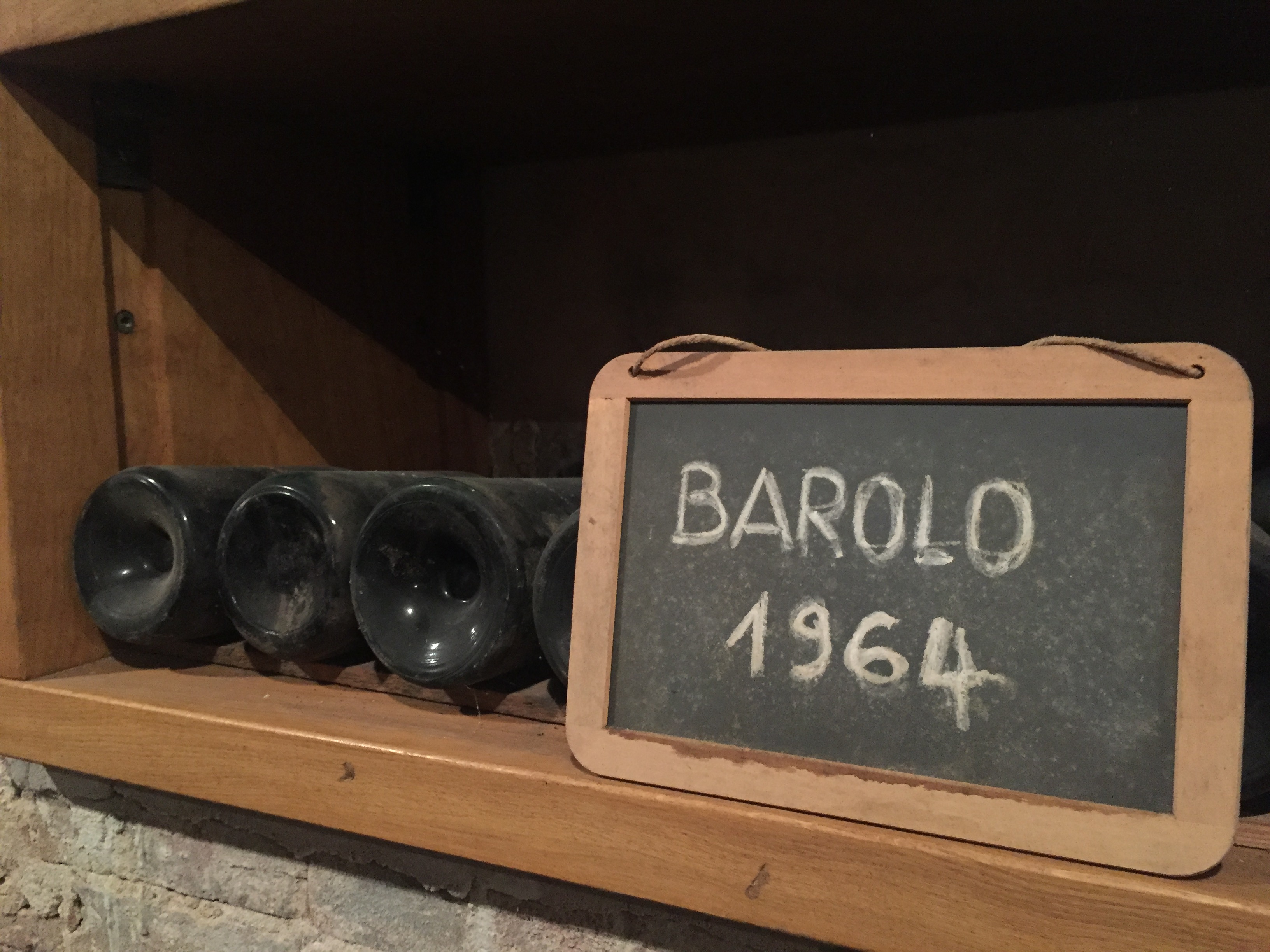
© Miles Davis, Wine Owners
The Wines
The wines we tasted were largely brilliant and we all agreed what a good reminder it was when we had our first poor tasting - it offered reassurance that we hadn’t become so inured to the place that we had become complacent! To be fair the Baroli we were tasting were mainly from the fabulous 2016 vintage and we were tasting at very good growers, some famous, some less so, but more on them later.
I was surprised by the approachability of most of the wines, a marked difference to previous experiences. The wines were pale, supple and elegant and with a weightlessness (something that perhaps Nebbiolo can deliver more than any other variety) yet packed with fruit, power and nuance at the same time.
Times have been a-changing in Barolo country and where they haven’t changed too much, the results have improved dramatically. The ‘Barolo wars’ are well documented, indeed there has even been a film made about them and concern the traditionalist approach versus the modern. Briefly, this translates into long maceration periods and ageing in large oak barrels (botti), the traditional approach, versus shorter maceration, temperature controlled fermentation and small oak barrels, the modern. It was interesting to note that the two wineries employing the highest percentage of small oak barrels produced the least good wines. The better wines were made in the traditional way but are harvesting better fruit, implying improved work in First floor.
As with other regions, alcohol levels in Piedmont have been rising, largely due to climate change. Most of the wines tasted were at 14.5%, but such are the natural acidity of Nebbiolo and the soils you really don’t notice, at least not until you’ve had the whole bottle yourself! It is a very different experience compared to drinking Bordeaux wines at the same level. Another local variety, Pelaverga, produces an even paler juice which is amazingly light and fruity. I had just started dreaming of summer barbecues when I noticed G.B. Burlotto’s offering weighed in at 15% - keep it away from the kids!
-G.B. Burlotto © Miles Davis, Wine Owners
The Market
As previously commented on here, the market in Piedmont wines is firm. Without the geopolitical issues currently hanging over the wider market, it would be a fair chunk firmer. The very loudly heralded 2016 will be released this year and buyers are waiting to pounce. If 2010, another great vintage, is anything to go by they most certainly will, and probably in far greater numbers than back then. In the grand scheme of things, Piedmont is an adolescent and will continue to grow. Wine making will continue to improve and prices will rise.
The Producers (in brief) (and not all)
Punset (Nieve) – previously unheard of (by me). Bio-dynamic and very in touch with climate and nature. Only releases when the wines are ready. Marina Marcarino’s Barbaresco Basarin 2013 (a year very similar in weather to the brilliant 1982, her first vintage) is available now. Delicious and only 13% alcohol. So desperate to make wine, she lied to her parents about the course she was taking at University. They wanted her to join their family widget making business – we were all glad she didn’t! Her range is just great, elegant and refined. She may even save the planet too.
G.B. Burlotto (Verduno) – Premier League status and I now know why! Verduno, at the northern tip of Barolo country, is the village of the moment and its best vineyard, Monvigliero, known for its elegance, is the piece of dirt everyone wants a piece of right now. Fabio Alessandria makes c. 8,000 bottles of Monvigliero - Investment Grade ‘A’. His whole range is superb.
Fratelli Alessandria (Verduno) – Cousins of Fabio and not to be confused with the Glaswegian band. Rising up into the Premiership. Traditional methods, improvements in the winery and focusing on improving quality, not expansion. Their Langhe Nebbiolo ‘Prinsiot’ 2016 is already in my cellar for drinking and I’ve been buying ’13 Monvigliero for investment.
Trediberri (La Morra) – Nicola Oberto and his parents bought a 5 hectare site in La Morra in 2008 and have 2 prime hectares of Rocche dell’Annunziata. Definitely one to watch, this guy is on the move and has been studying Bruno Giacosa’s methods. Refreshingly honest, he was genuinely most excited about his recently made Annunziata 2019 - at three months of age! The Langhe Nebbiolo ’19 might be one to sample. Moving from on the radar to gentle accumulation…
Trediberri (La Morra) – Nicola Oberto © Miles Davis, Wine Owners
Roagna (Castiglione Falletto and Barbaresco) – Now in the hands of Luca Roagna, they are one of the few growers making really serious wines in both Barolo and Barbaresco. The star has been rising for some time. Organic with old vines. We tasted wines from the poorly reviewed 2014 vintage (he releases later) at 10 degrees in the cellars. Although the wines were also cold, they sang their heads off. Both from Barbaresco, the Albesani (2,000 bottles) with the most amazing nose and the Montefico (1,000 bottles) stood out for me. Invest with confidence!
Crissante, La Morra – not on my radar before, Alberto has been running this family affair (we met Nonna (his nan), 88 and still dancing) since 2008. The family owns 6 hectares of vines, 5 of hazelnuts and a lovely holiday house they rent out. The Barolo Classico ’16 will ticks a lot of boxes when released. Thier Capalot ’15 will also give immense pleasure. The ’13 is currently available. Firmly on the radar now.
Bartolo Mascarello, Barolo – Investmnent Grade A. Brilliantly understated and traditional with a touch of jazz, but only in the artwork on display. Maria Theresa’s 2018 Dolcetto was superb, the ’16 Barolo sublime. A blend of 4 vineyards with production at 15-20,000 bottles. Genius. Interesting to spot an empty Trediberri box by the back door!
Giovanni Rosso (sounds so much better than Red John!), Serralunga – Proprietor Davide turned up as we were leaving, completely unphased by his tardiness. How someone so laid back has managed to create such a bustling business is amazing; two tasting rooms, one with a full restaurant style kitchen, a helipad, a contract to make BBR house Barolo and sales all over the world. Our impromptu host excelled in showing us the famous Vigna Rhionda vineyard. Once our feet were double caked in clay he informed us the terroir was nearly all limestone! A rushed tasting followed which was a bit inconclusive but with their top cuvée selling at £500+ a bottle, something is working. Another visit required!
Luciano Sandrone, Barolo – impeccable presentation. Famous for their Barolo labels Cannubi Boschis (Aleste since 2013) and Le Vigne, and now the uber rare Vite Talin, that they vinify themselves, they not only sell a lot of grapes from their Roero sites, they also sell finished wine to others. A mixture of traditional and modern. Barbara works with her Uncle Luca, only 3 years apart in age and Luciano (Barbara’s father and Luca’s brother) is still on site having begun his wine life with Giacomo Borgogno, bang next door and right under the slopes of the Cannubi Bioschis vineyard. Great 16s, the 15s also very attractive. Lovely wines, I have been buying and will continue.
Sandrone © Miles Davis, Wine Owners
General comment
It was an inspiring trip and easily surpassed expectation, particularly in the wine department. Growers tend to be family run businesses, are friendly, engaging and genuinely passionate. The bigger businesses are the antithesis of this and, dare I say it, more reminiscent of Bordeaux producers. These personalities are clearly reflected in the wines and different styles are very apparent.
On my return to my desk I found the tail end of the Burgundy 2018 en primeur offerings. The relative prices just do not make sense. On every level, there is no comparison; there are dozens of Grand Cru Burgundies from a host of producers releasing wines at more than c. £150 a bottle, in Piedmont a tiny handful. From a recent release of Giacomo Conterno’s 2015 wines, only the legendary Monfortino (the most expensive wine in all Piedmont) was above this price level. Many Burgundy premier crus cost more than exceptional Barolo cru, village wines more than ‘classico’ blends etc., etc.
For drinkers and those wishing to dip their toe, all of the producers make an entry level wine, be it a Langhe Nebbiolo, a Langhe Rosso or a Nebbiolo d’Alba. These are released earlier than the aged Barolos and offer an inexpensive way of treating yourself and opening the door.
As ever, please fire away with questions.
© Miles Davis, Wine Owners
by Wine Owners
Posted on 2019-02-07
On the gastronomy front an incredible meal was enjoyed at Le Cinq in Paris, bearing absolutely no resemblance to Jay Rayner’s very amusing description from a couple of years ago, to be found here.
Visually, texturely and tasting-wise it was amazing, even if not everything agreed with everyone. Turbot, venison and onions remain firmly in the memory. Jay needs to revisit!
Chateau Grillet’s second wine, (rather understatedly) labelled as Cotes du Rhone was discovered here and what a beauty it was, although seemingly impossible to find in the U.K.
Another first time experience enjoyed was L’Assiette in the Montparnasse part of town, a neighbourhood restaurant sending out glorious French classics with a modern twist, but not in the case of the cassoulet – that was just classic! There a new discovery on the wine front was made, Romain Pertuzot, whose Chorey Les Beaune 2015 was bright, tense and juicy.
Sadly, the legendary Tan Dinh, the Vietnamese restaurant in St. Germain, whose regular customers once included the likes of Steven Spurrier and Paul Bowker back in the day seems a little tired. Under seasoned and under spiced food, the list is not what it once was but still heralded some beauties none the less. There is an impressive list of Barthod, Coche, Mortet and Niellon, amongst others, although the latter will not be served, whatever the vintage, due to premox issues - very worrying indeed! A Clos l’Eglise ’78 was full of old world charm.
There was a superbly curated Ledbury lunch will other top drawer collectors with Haut Brion ’96 leading the way, pursued by Palmer ’89 and admirable examples of ’02 white Burgundies, Le Clos from Raveneau and Henri Boillot’s Puligny Montrachet Les Pucelles, all preceded by a gorgeous 2010 Keller Abts E Spätlese.
Dry January will have to wait yet another year!
by Wine Owners
Posted on 2018-12-17
Ahead of the new 2017 releases in early 2019 it's time to report on Burgundy and its news.
2017
Another warm summer produced accessible, fruity wines.
Left to do their thing, the vines were wont to produce very high yields especially in areas hit by frost damage in 2016 as the plants strove to compensate. Yields in Chardonnay were as high as 80 hl/ha. Now that’s a lot.
With a long run of short harvests stretching back to 2009 for several communes, the temptation was to let nature’s abundance run unabated. The trouble is, pinot noir is particularly susceptible to a large crop, so the trick in 2017 was to work to constrain yields.
Just as many over-cropped 1999s are now showing flat, far from being the great wines they might (and should) have been, we shall see which producers in 2017 haven't applied the brakes hard enough in due course.
For those who produced normal yields, 2017 is a delightfully juicy, fruit-forward year. Yet the best wines have more than just fruit: there is a fine mineral structure, a chalkiness and salinity that complements the raspberry coulis, kirsch, griotte, plum and fruit pastille characteristics.
The best pinots show appealing sucrosité with plenty of supporting freshness, which contributes to a sappy, mouth-watering persistence.
Above all I loved the harmony, balance, progression and energy of the best reds. I wouldn’t be surprised if they never shut down, and stay delicious from early on in their development throughout a moderately long drinking window: after all the 1997s are just about still hanging in there these days, and the 2017s have the potential to be rather better.
The perfect 2017 pinot has flowing raspberry fruit, a vinous, kirsch-like refinement, an infusion of Seville oranges and hints at a darker side with liquorice and spice.
The question mark over 2017 is whether a proper degree of intensity has been achieved. The vintage doesn’t seem to reach the same level in general as 2016, and yet the greatest 2017s do rival (and in a few cases surpass) their 1 year old siblings.
2017 is also very much a vintage where the appellations are reflective of their classification. Stepping up through a range from Bourgogne, through village wine and premier cru up to grand cru feels like an exercise in stepping up through the gears, with more oomph and interest at each change.
Whites are generally delicious as long as yields were tightly managed, and though the acidity levels were apparently a little less than in 2016, the very best still show a notable pithiness, a chalkiness and a bright intense citrus core that successfully counterbalances a tropical fruit character of pineapple and guava.
2018
Looking ahead to 2018, this is going to be a very tricky vintage. It was really hot, and the choice of picking date will have been critical.
Many producers were searching for perfect phenolic ripeness, waiting until the pips indicated an expected level of maturity. Some producers believed that perfect phenolic ripeness was not the only deciding factor for picking a harvest date in 2018. Those that were concerned about alcohol levels went early. They got their grapes in as early as the start of the last week of August finishing during the first week of September.
Producers needed to avoid too much extraction in 2018 for fear of introducing bitter flavours, especially those who had gone early. The gentlest of infusions seem at this very early stage to be the making of the best wines. Even so you won’t see many wines straight out of barrel with that trademark shining ruby robe of classic burgundy in 2018.
The most exciting wines tasted from barrel were made from grapes carried in at around 13.5 degrees but there are tales of 15 or (even!) 16 degree behemoths, whilst 14.2-14.5 degrees feels like a norm in the vintage.
The early pickers were fearful of what might happen if they let the alcohol levels rise too far, and they were evidently right. There were very real risks of partially completed fermentations and consequent high residual sugars in the juice. Several producers we spoke to had a battle to restart stalled fermentations, typically by tipping in the lees of another wine that had completed its fermentation more successfully.
The wines are largely dark purple or purple-black, opaque in appearance, and unsurprisingly show exuberant New World fruit and tend to have a mouth-coating texture due to the higher alcohols. There are some who argue that this is a very great vintage in the making; that vintages like 1947 were very hot indeed and yet they have transformed into great old bones. Taking a necessarily broad view at this early stage I would suggest that there are likely to be a rather small number of potentially very great wines.
Amphorae
Fourrier continued experimenting with Amphorae in the 2017 vintage with La Combe aux Moines, but they are sure to come into their own for 2018. The terracotta enables the wine to breathe whilst acting as a totally neutral vessel. This accentuates minerality and produces a wine – if unblended with wine aged in wood – that would be too strict. Certain of his wines including Clos St Jacques and La Combe aux Moines have a proportion of the production being aged within these fabulous looking clay containers for the 2018 vintage. The finished wine will be blended with the other part of First floor in barrels. It will be fascinating to see the results – could these turn out to be some of the greatest wines ever made at this wonderful domaine?
2017 – The year that distribution changed
Producers are not blind to the fact that certain merchants have been selling their UK en primeur allocations to Asia, notably Hong Kong. They are not happy to discover that importers cross geographical boundaries, even if the wines sold may be subsequently stored for a period of time in the UK.
Nor are their agents impressed, who have the clout to recommend their producers shift allocation to where demand is currently being met indirectly.
As a result certain top producers have withdrawn a significant part of their allocation to the UK in favour of Asia, even though there is much more wine this year to go round - in some cases up to 3 times the quantity of 2016.
2017 pricing
With Brexit uncertainty depressing the Pound, more wine not necessarily translating into larger allocations for the UK, and the secondary Burgundy market having risen substantially during the course of 2018, there are few reasons to imagine that prices will fall. Which makes it a tricky call for consumers who don't want to lose their allocations and yet this is one of the most uncertain of times. High release prices for great vintages such as 2015 and 2016 were swallowed. We will have to see how digeste 2017 proves to be.
by Wine Owners
Posted on 2018-10-17
When tasted from barrel in the spring of 2017, it was very evident that this was a vintage with loads of extract, with one of the highest ever IPT levels ever recorded in Bordeaux. IPT is a measure of the combined phenolic compounds in the juice - principally tannins and colorants responsible for the red, purple and blue hues in grapes. Large bunches of rather small berries meant high skin to juice ratios.
We suspected that the finest wines were those who extractions were gentle - neatly summarised by Frédéric Faye at Chateau Figeac who described their fermentation process as an ‘infusion’ with the gentlest of extractions achieved from the submerged cap.
With the proviso that the 2016s have been in bottle for as little as 3 months, this was an opportunity to re-taste a selection and test our original impressions from 18 months ago.
The more extracted wines with highest IPT levels were evident, and at this stage it has to be said that they were the least harmonious. Where there was a desire to make full use of, or to accentuate, all the elements proffered by nature, the palate tended to be dominated by raw power, the scale undeniable but at the expense of charm for now.
The structure of 2016, hidden under a cloak of velvety fruit and sweet tannins when barrel samples, was much more evident now the wines are in bottle, and this structure allied to tremendously aromatic fruit in the best examples, affirms 2016 as a vintage with some truly great wines in the making.
It’s not just a great cabernet sauvignon vintage either, with some of the right bank merlots absolutely stunning. La Conseillante that had seemed a little sweet and svelte at the property in April 2017 is now brilliantly pitched, with extremely expressive and aromatic fruit held in check by an impressive frame of tannins.
What was slightly surprising however, was the wide variation. Those who are tempted to categorise 2016 as a uniformly great vintage will be disappointed; there is plenty of dull wine. The difference between the vintage's heights and the good average is a chasm.
The Northern Medoc had an especially successful vintage, with Cantermerle showing excellent concentration and focus, and my pick of the appellation at en primeur, Citran, showing all of its former promise and more. Could this be the bargain of the vintage?
Domaine de Chevalier has made an epic red, with great substance and lovely resonance, and on this showing had the better of the high-in-cabernet-franc Carmes Haut-Brion. Though evidently fine fruited, Haut Bailly’s firm tannins are a bit overwhelming for now. Both Pape Clement and Smith Haut Lafitte major on great substance and scale, but show a raw or unknit character at this early stage.
Canon was showing very defined fruit with loads of grip but for now felt very slightly loose on the finish. Figeac has managed to combine stunning definition, texture, harmony and length and on this showing must be a 100 point wine in the making.
Gazin was absolutely charming with an impressively solid core. La Conseillante as already mentioned was a hit.
St Estephe and Pauillac were as good as expected given how fine the Cabernet was from this upper part of the Medoc peninsular, and wines from Cos Labory and Phelan Segur were notably excellent at their price levels.
Clerc Milon had stood out as exceptional in April 2017, and now in bottle shows impressive density, a huge finish and attractive gaminess. D’Armailhac was extremely exciting, packed with red fruit and finely beaded acidity and plenty of accompanying structure. Pichon Longueville Comtesse was one of the stars of the en primeur tasting and once again stood out for its super-refinement: unquestionably a top wine of the vintage.
In St Julien the Bartons stood out. Langoa was svelte, intense, showed gorgeous scale and definition at a very attractive price point. Leoville Barton was another league and heads above the other St Juliens. Huge, but super fresh, light-footed, with a mouthwatering blood orange infused core and a very direct, linear finish. One of the greatest wines of the vintage.
Lagrange was fine, the tannins so ripe and silky that their velvety texture cloak its underlying structure, just as it did when tasted in London a year ago. Talbot was back to it’s very best, likely up there with its beautifully balanced 1982.
The Margaux appellation in the main was not quite as exciting as the magnificent 2015s, a vintage in which the commune excelled. However one stood out for it’s stunning definition and extraordinary elegance. A fitting wine to finish this round-up of 2016s in bottle. Beautifully textured. A wine that simply flows across the palate with effortless grace. It helps that it’s also one of the most under-rated wines in the whole of Bordeaux, sitting as it does on great terroir. The wine in question is Chateau Dufort-Vivens, Second Growth Margaux, fully biodynamic, and an outstanding success in 2016.
by Wine Owners
Posted on 2018-10-16
We had the pleasure to share a wonderful Chateau Margaux dinner with our members and the estate's ambassador Thibault Pontallier at La Trompette last week. The line up encompassed Chateau Margaux 1983, 1986, 1989, 1990, 1996, 1999, 2004, and a surprise magnum of 2000, preceded by Pavillon Blanc 2015 and Pavillon Rouge 2000 and 2009.
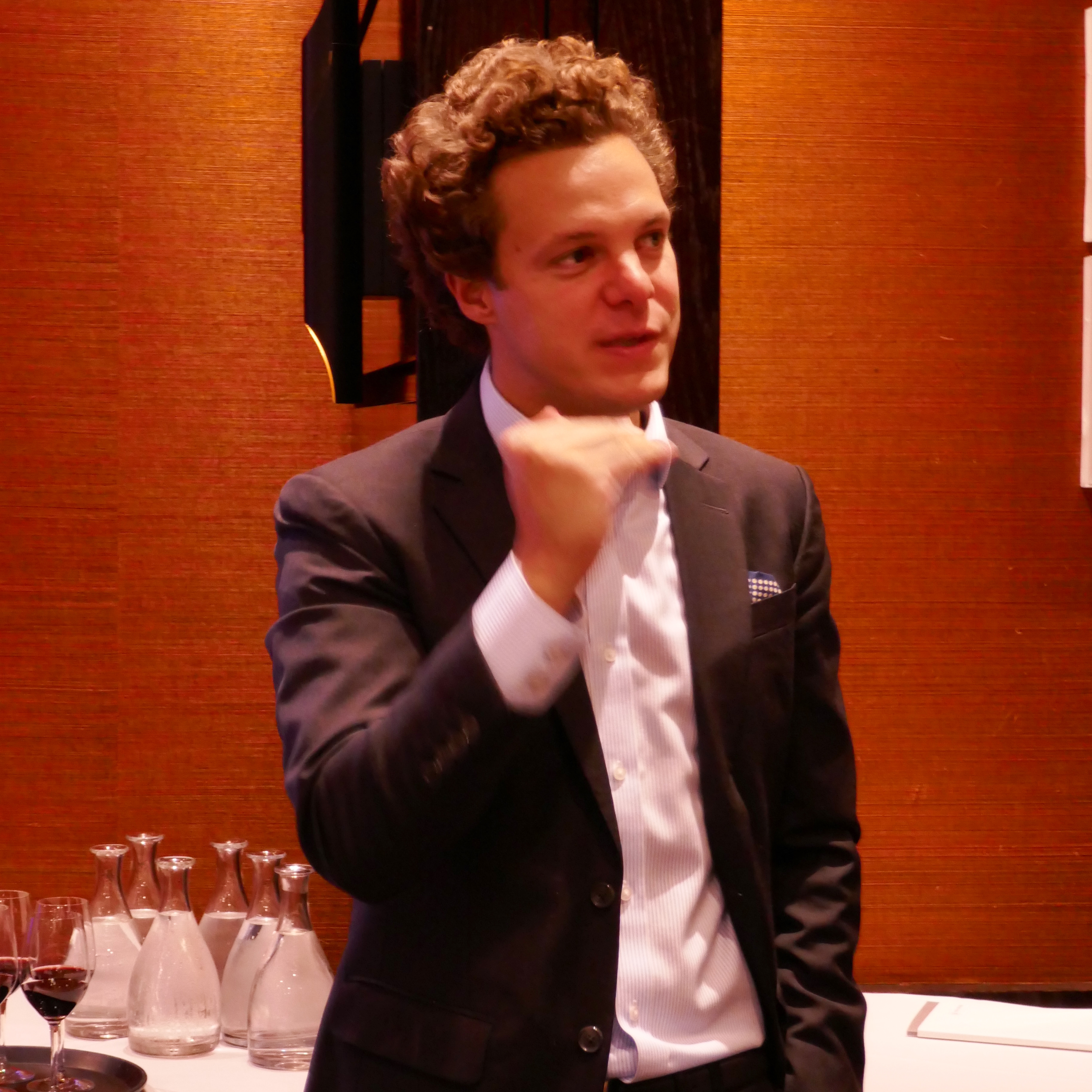
Pavillon Blanc 2015
Mineral nose, chalky, white currants, and saline. In other words a lot going on! Bright attack, palate follows the profile of the nose with addition of seville oranges and attractively bitter pith, green guava, and a fruit bush leafiness before ending on a firm finish.
2022-2030
94
Wine Owners view
A great investment in future drinking - one of the most complex of white Bordeaux, with refinement and structure for the long haul, and will be impossible to find in the future.
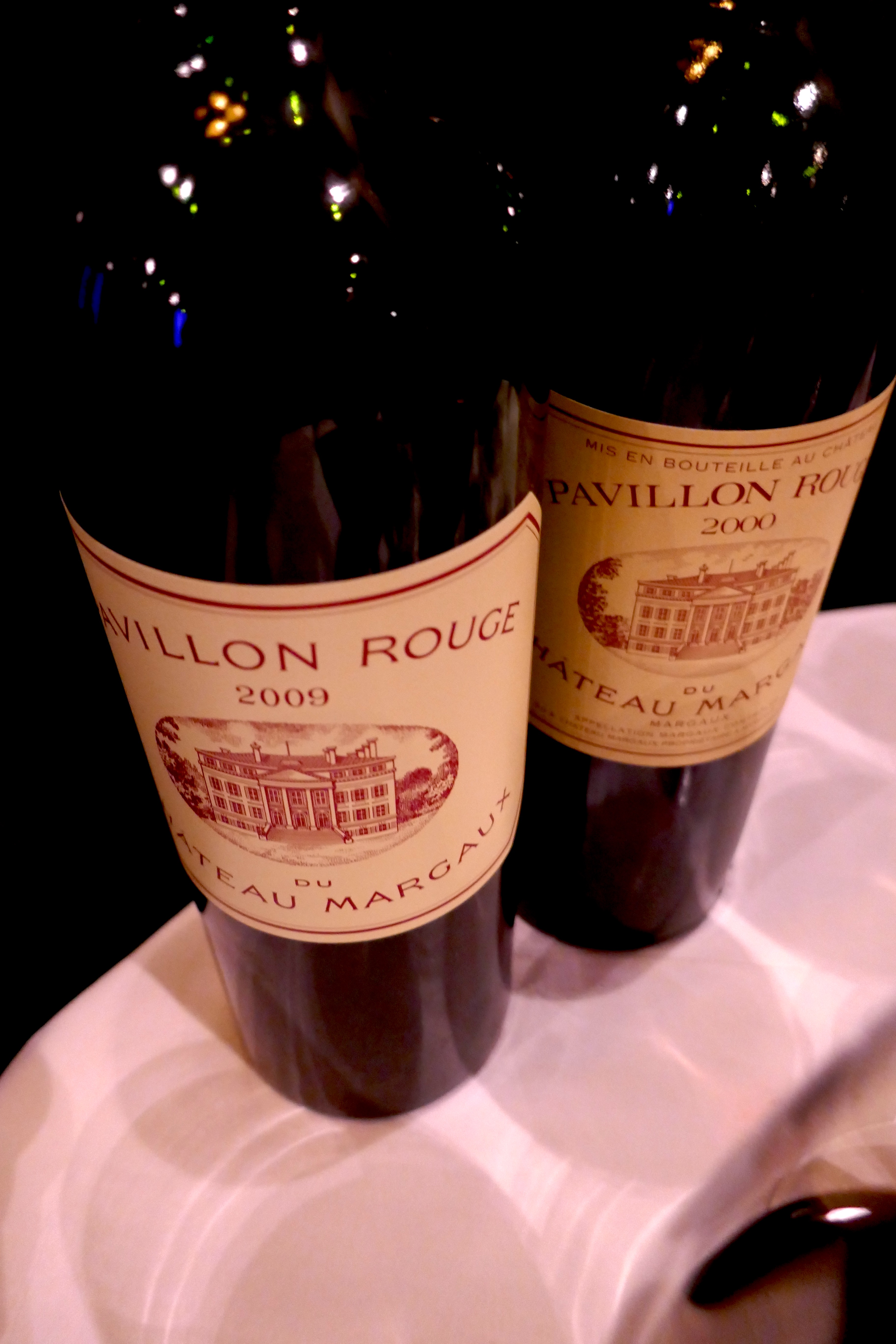
Pavillon Rouge 2009
A controlled, spicy nose, intense cassis, fresh blackcurrant leaf. Surprisingly cool from such a warm vintage, great grain to the wine’s texture, full of future promise, with depth and focus.
2023-2035
93+
Wine Owners view
Hitting the level of a second growth, Pavillon rouge is a grand wine in 2009, more expressive than the Grand Vin at this stage, yet with the same sense of balance and poise. Chip off the old block.
Pavillon Rouge 2000
Complex pine infused nose. Dry aromatic attack, gorgeous definition and a fine persistence. A touch of gaminess, roses, and spruce tips on the mid palate, the fruit evolving into a broad savoury finish enlivened with sappy, uplifting acidity.
Now to 2025
95
Wine Owners view
Mature and exciting with lots of complexity within which it’s easy to pick out individual flavours. So plenty of wine to make a special occasion a bit more special.
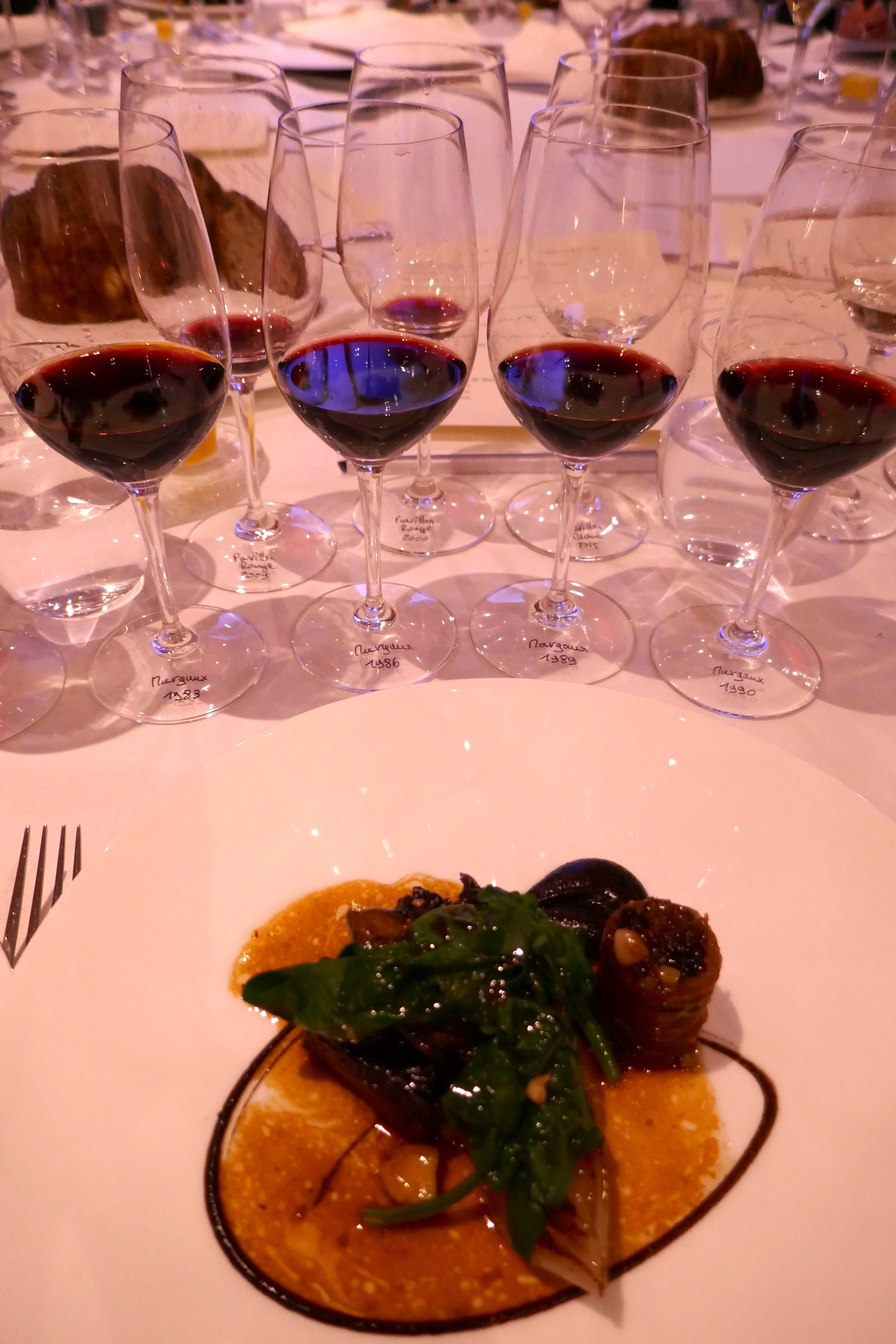
Margaux 1983
Aromatically expressive, a spiced attack preludes a charming medium-weight classic claret of supreme elegance and harmony. A gentle finish that nevertheless remains very elegant and delightfully complete.
Now to 2023
93
Wine Owners view
A great drink for right now, majoring on Margaux’s famed subtlety. Still possible to find in the secondary market around £350-£400 per bottle, which given its age and refinement is something of a steal. Hard to think of better First Growth value for money.
Margaux 1986
Heady, spiced, with a touch of iodine creating an intoxicating blend. Resolved on the palate, very good intensity allied to racy acidity. Fine scale with oranges and cloves on the long finish.
Now to 2025
95
Wine Owners view
1986 was a happy surprise due to the energy and resonance of the vintage. We wouldn’t keep it much longer but another strong buy for drinking around £400 per bottle.
Margaux 1989
Gorgeous overt nose, great length and grain, sappy with rising aromatics, a twist of liquorice and a cloved finish.
2020-2035
94+
Wine Owners view
The generosity of the vintage is evident on the nose, yet the accomplishments of this wine are still hidden, and there’s a sense of more to come. That grainy texture and gorgeous spiced finish are surely harbingers of great things in store for future drinking. As a result, a decent investment to boot for a 10 year view.
Margaux 1990
Saline, gamey nose and an energetic and velvet-textured attack, counter-balanced and infused with blood orange. Great resonance and breadth, visceral, spiced finish, and a whiff of very attractive sweet chloroform right at the finish. Very, very long. A great wine.
Now to 2030
98+
Wine Owners view
The velour and silky density of this wine makes it a beauty for enjoyment right now, and sure enough it was wine of the night for the majority of attendees. There’s more to go but will it ever be as lovely as it is now? Expect to pay £720+ per bottle so one for the collector who is looking for the very best vintages of Margaux.
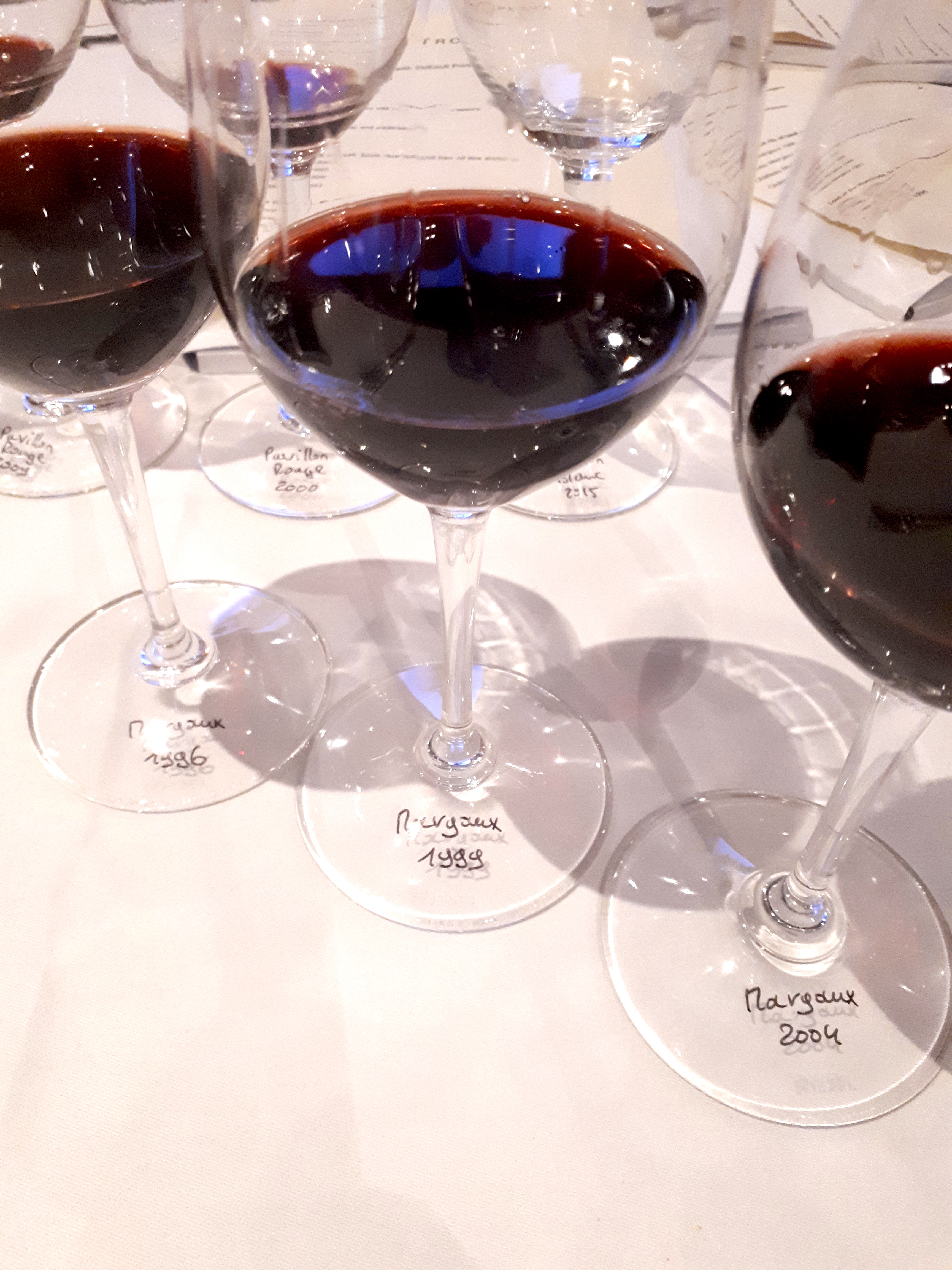
Margaux 1996
Svelte Nose, and then at the outset, so young and fresh. Tannins still present. A large scaled, monumental wine of extraordinary length yet extremely primary. An absolute baby in other words! With time in the glass the aromatics really open up. There is great intensity and a wonderful centre to this wine. Tonight 1990 gives more pleasure, but the sense of energy and drive in this wine along with all the other elements suggest a great, great Margaux in the making for 2025 onwards.
2025-2050
Wine Owners view
This is going to be mind-bendingly good. Though it lacks the resolution and some of the warmth of the 1990, it makes up for that in sheer energy, focus and intensity in its core. This elemental wine is still good value at around £500+ per bottle and would be an obvious choice as an investment, or buy now and wait 15 years to for a thrilling vinous experience as close as any gets to a concept of the perfect wine.
100
Margaux 2000 (Magnum)
A wine that is already resolved but at the beginning of its plateau. Spiced, cloves, sweet chloroform. Great energy, definition and depth on the finish, enlivened by a fine thread of acidity that uplifts the fruit. Very long and all the while gaining in energy through the impressive finish.
2018-2033
97
Wine Owners view
The overriding sense one has here is of harmony. Balanced and complete, spiced and heady with the signs of further maturity a short few years away. For many palates this is completely ready but an interesting addition to any Bordeaux lover’s cellar for its immediacy and near term potential.
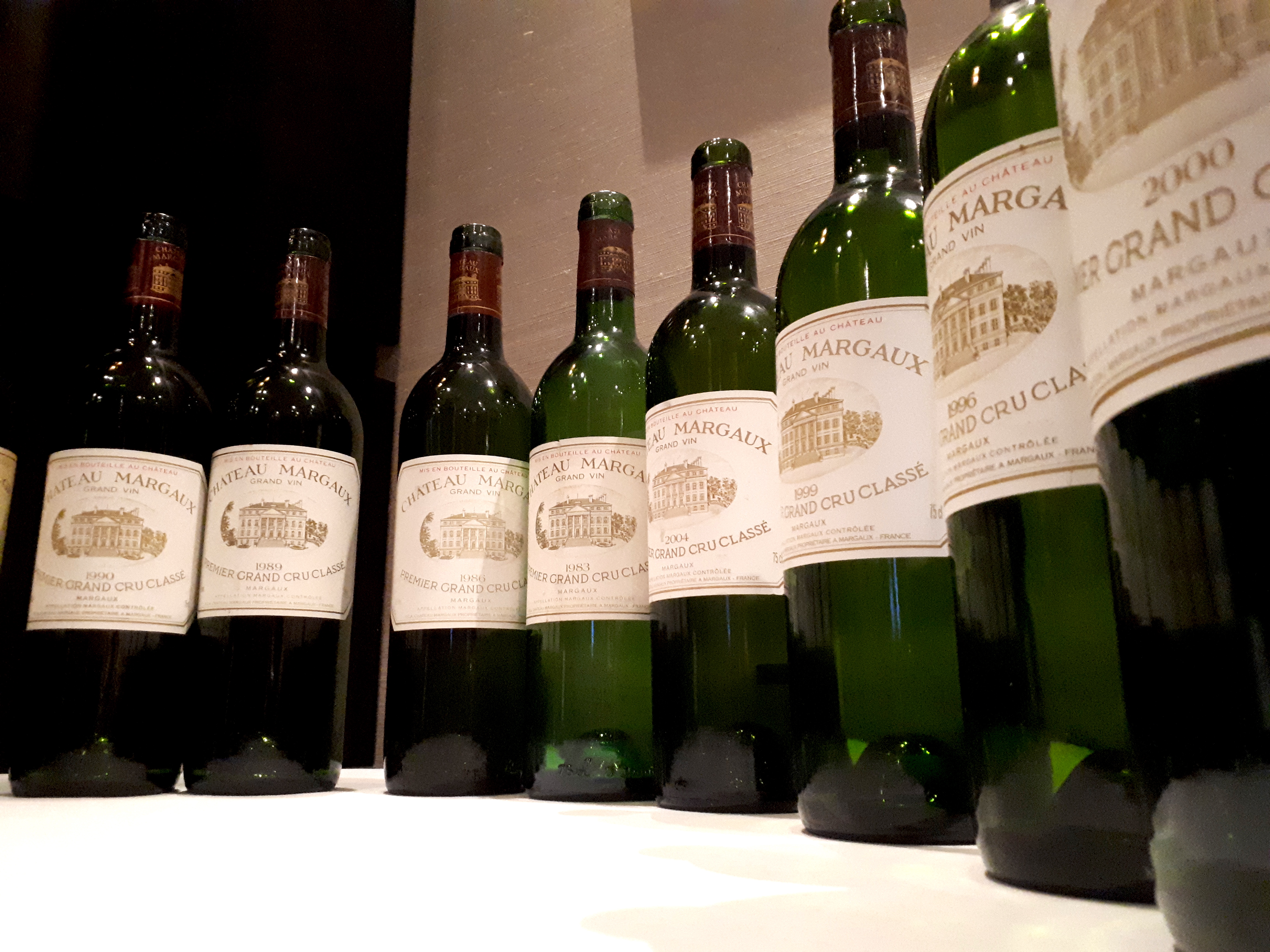
by Wine Owners
Posted on 2018-05-30
[Last week, the Wine Owners team tripped along to Lords, to taste a range of top 2017 Bordeaux wines en primeur. Below is a contribution from Artemis, the newest member of the team...]
What could be been better for a mid-May Thursday than a large tasting of Bordeaux Grand Crus at Lords Cricket Ground?!
The tasting included wines from over fifty chateaux, each bringing two vintages: 2017 and one other back vintage. Determined buyers and tasters were able to get around the whole room, while others focused on either the left bank or right bank, or maybe their favourite producers. Here are some great value attention-catchers.
Delicious Fruit
Some wines with very good fruit expression, and also notable for their value, were La Tour de Mons and Meyney. The tasting duos were 2014 & 2017 for La Tour de Mons and for 2015 & 2017 Meyney. These are an absolute recommendation especially if you have now started working on your cellar.
- La Tour de Mons 2017: £164
- Meyney 2017: £228
- La Tour de Mons 2014: £190
- Meyney 2015: £295
On the same spectrum at a nearby stand were Lafon Rochet and Cos Labory with their tasting pairs. Both of these wines offer very good fruit and ageing potential, Lafon with a rounder mouthfeel and Labory with a spicier finish.
- Lafon Rochet 2017: tbc
- Cos Labory 2017: tbc
- Lafon Rochet 2014: £285
- Cos Labory 2011: £240
Fresher Styles
In the photo here are Chateau Pibran on the tasting table, next to d’Aiguilhe. Both of these will please those who enjoy fresher Bordeaux expressions with texture and minerality. Pibran is handled in the same facilities as Pichon Baron, and can be a nice addition for a diverse wine portfolio.
- Pibran 2017: £280
- d’Aiguilhe 2017: £180
- Pibran 2014: £225
- d’Aiguilhe 2014: £150
Similarly, d’Aiguilhe was tasted next to its big brother, Canon La Gaffeliere (Saint-Emilion Premier Grand Cru Classe B). This Cotes de Bordeaux wine retains freshness and is a very good introduction to the wines of the Von Neipperg vineyards.
White & Sweet Surprises
En Primeur tasting means racing tannins, so a break was required from the full-bodied reds, to explore sweet and dry whites. Dry, old-vine Semillon-dominated, 'S de Suduiraut' from the eponymous chateau offers concentrated flavours, along with substantial freshness and minerality. Luscious Clos Haut-Peyraguey 2014 & 2017 from Bernard Magrez was the perfect way to close the tasting, after a mouth watering duo of Pape Clement Blanc (2006 & 2017).
- S de Suduiraut 2006: £230
- Clos Haut-Peyraguey 2017: £290
- Clos Haut-Peyraguey 2014: £350
by Wine Owners
Posted on 2017-10-09
The first of 3 dinners to taste through 61 red Bordeaux ‘Growths’ classified in 1855, the 2007 vintage had been kindly provided by 2 wine enthusiast brothers who were keen to share this extensive horizontal with fellow members.
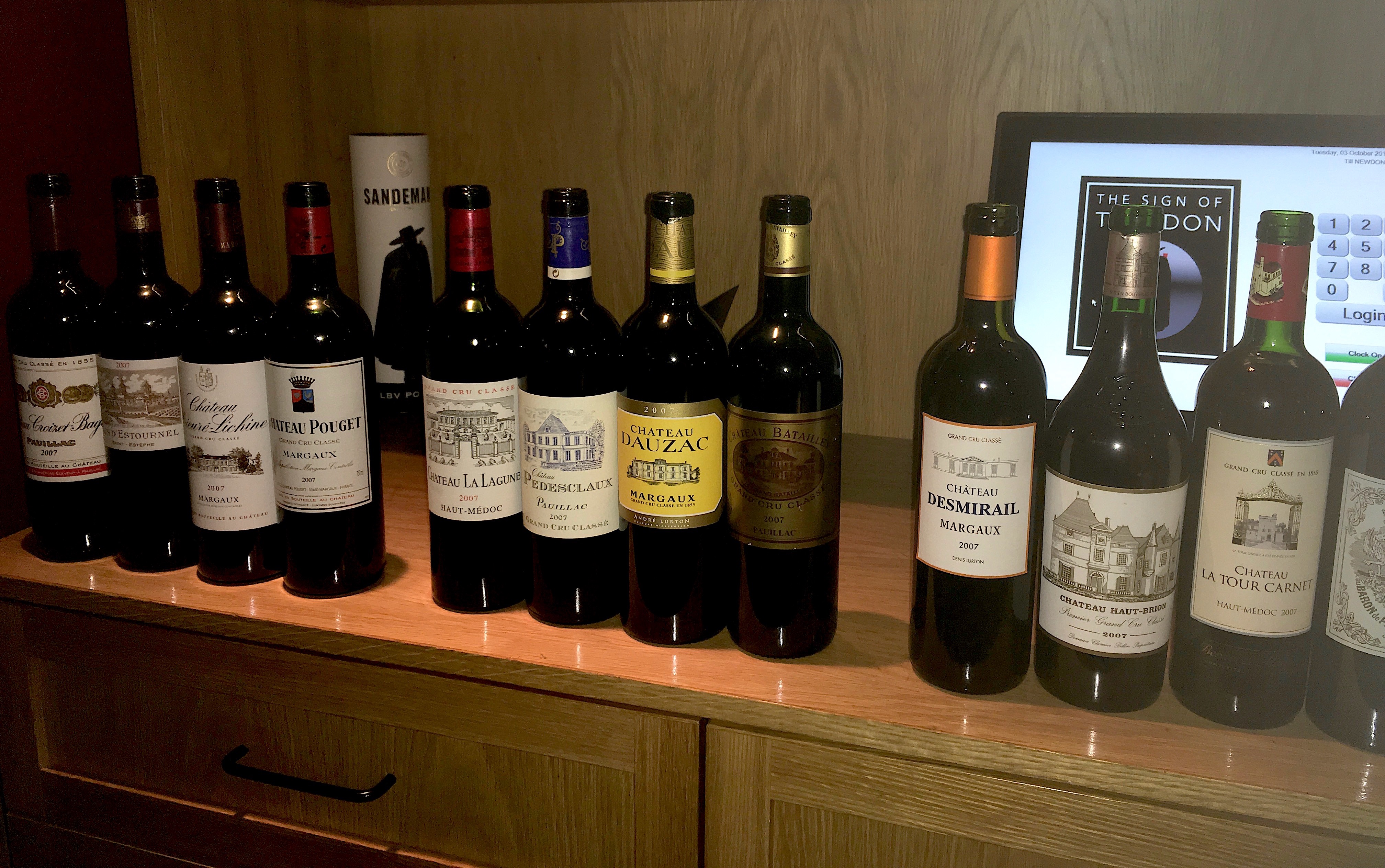
The wines were cleverly organised into suitable flights to accompany each dinner course by Christopher Delalonde, resident Master Sommelier at The Don on St Swithins Lane, ensuring a peak was hit with the glorious venison main course, with further high spots to be enjoyed in the tail-end of supporting wines.
Christopher Delalonde
Given the less than enthusiastic press on the 2007 vintage, the wines showed a remarkable degree of consistency. 2007 was not a vintage to try to force, and the great successes at all levels of affordability and rank were those founded on balance and the natural aromatics of the vintage. Whilst bargains are far and few between, some of the lesser known Crus still represent good value for money. At the top end, the Firsts and most of the Seconds showed their class and the value of their top terroirs.
| Cru | Note | NM Score |
| Croizet Bages, Pauillac, 5th | Fruit forward, spiced nose. Licorice leads the creamy attack, round supple mid palate. Fresh orange zest on the finish provides focus and suggests there's plenty of scope for near-term future development. Still young and promising. | 92 |
| Cos d'Estournel, St Estephe, 2nd | Cool nose, spiced and generously perfumed. Savoury with with a saline element, and a texture reflecting fine, grainy tannins on the already resolved attack. Lifted, sappy, fruity mid palate and a finish that ends on a sweet crescendo. Delicious already, with plenty of future potential, and avoiding the overextraction of 2009/2010 vintages. | 95 |
| Prieuré Lichine, Margaux, 4th | Cool, spiced nose with trademark Margaux perfume. Savoury attack and mid palate, with a blast of licorice. A little obvious and currently a disjointed finish. Mid weight, but this might just be a bit young and yet come together. | 88 |
| Pouget, Margaux, 5th | First time I've ever tasted this Cru? That I can recall. Lovely, sappy nose: a sense of freshness and vitality. Fruity, rounded attack with the dry character of the fruit lending firmness. Mid weight mid palate, with an intriguing orange zest twist to the finish. Balanced and attractive. One to seek out at a bargain price as a household staple for Sunday lunch, given it's anonymity (and relative lack of buyer interest) in the market? | 91 |
| La Lagune, Haut Médoc, 3rd | Perfumed nose betraying it's proximity to Margaux to the North and close to La Garonne. Energetic attack, meaty notes, and lightly spiced blend to create a strong appeal. Only a medium length finish lets it down, but still lots to like. | 90+ |
| Pedesclaux, Pauillac, 5th | Pre the recent renaissance under Lorenzetti, who since 2009 bought 12 hectares next to Lafite and Mouton to enlarge and improve this forgotten Cru. It needed rescuing based on this showing: Licorice infused nose, slightly bright point of attack, nice density but with a bright acidity that isn't integrated and overall paraxodically shows as rather neutral. | 86 |
| Dauzac, Margaux, 5th | Spiced nose, savoury and round. Rather dull and flat in character. Recalls the edgeless wine recipes made by producers for Naked Wine. Think Barry Manilow (unless you like Barry Manilow in which case think of someone else). | 84 |
| Chateau Batailley, Pauillac, 5th | White pepper seasoned nose, griottes and cedar. Attractive cedary attack too with enough acidity to be mouthwatering. Firm, classic claret with enough cut to accompany the foie gras. Being picky, the mid palate came across as hollow on this showing. | 88+ |
| Desmirail, Margaux, 3rd | Quite a neutral nose, on its reserve. Restrained. But the texture shows grainy tannins, offers an elegant intepretation of the appellation, and shows good persistence. The mid palate is dominated by its savoury character at present. Given it was part of the vast Rauzan estate in olden times (together with Rauzan Segla and Gassies), it probably should be offering more than is evident today. | 88 |
| Haut Brion, Pessac, 1st | Liquor-like aromas intermingle with perfume on the nose. There's a stunning, illuminated attack with crystalline red fruit predominating. Superb energy driving into the long, long finish. Primary for now, this is not yet showing any of the unique Haut Brion Graves character one might expect, of charcoal, smoke and stoney minerality. It will come in time - give it 15+ years. Demonstrating once again how good Haut Brion is in off-years (or average years to give 2007 its dues). | 96 |
| La Tour Carnet, Haut-Medoc, 4th | As ambitious as its master, Bernard-Magrez, this is a big wine. A liquory nose leads you in, where the palate is rich, with confit fruit leavened with cedar. Modern but nevertheless quite impressive, it offers value and should settle down with age into a gentler form with a little more refinement. Very recent vintages have pulled back are are a bit more restrained. | 89 |
| Pichon Baron, Pauillac, 2nd | Very creamy nose, anis seeds adding aromatic complexity to the dominant oak influence. Huge cedary attack., sweet fruited mid palate, where the spice and licorice kicks in. Creamy oak influence evident here too. Impressive in its style, but I personally would have preferred more elegance for a Super Second. Yet it's young, needs time, and is an engaging wine for those who are attracted to its powerful form. | 92+ |
| Calon Ségur, St Estephe, 3rd | Always a 'giving' Cru with a good dose of Merlot, the nose immediately shows off its fruit, which is shot through with graphite. Nice intensity to the attack, creamy yet balanced, with an underlying exuberance that's contained. Medium length to the finish which ends a little flat. The ending lets the whole down for now, but may well gain in energy and interest with age. | 92+ |
| D'Issan, Margaux, 3rd | Another estate owned by Lorenzetti, who has been making improvements here for longer than at Pedesclaux. Fruity nose, with gamey notes and a trademark D'Issan salinity. There's a super energy to the mid-palate, fruity then savoury and with great progression. Super-fresh, bright acidity is well integrated into the fruit, and is unforced in its style though I'd prefer a touch more finesse. This should develop very well with time, and should make finer old bones. | 92 |
| Lafite, Pauillac 1st | Creamy nose, black pepper, but very much on its reserve. Superb intensity and an aromatic, floral quality to the fruit. This is defined at this stage of its evolution by refined tannins, is very persistent on the palate and leads into a rich, confit lemon finish. Stunning but terribly young for now. Should be magnificant in 10-20 years. | 96+ |
| Beychevelle, St Julien, 4th | White pepper nose, a fine attack and a round mid palate, nicely integrated but a bit simple overall. For the cash, one expects more. | 88 |
| Kirwan, Margaux, 3rd | Perfumed nose, confit, sticky fruit on a rich attack leading to a thickly textured, disjointed mid-palate. I can't help feel it would be a lot more interesting if it followed the less interventionist approach of D'Issan. Disappointing. | 88 |
| Grand Puy Ducasse, Pauillac, 5th | Perfumed nose, licorice notes, Firm attack, medium weight fruity mid palate with the right amount of freshness to lend lift and definition, and a citric thread driving the finish. Surprisingly good. Perhaps we're so used to the excellence and consistency of Grand Puy Lacoste we're overlooked a 'value' Growth here? | 91 |
| Leoville Barton, St Julien, 2nd | Balanced, classy perfumed nose is a big step up. Very energetic attack leads to a mid palate showing real complexity, mixing savoury notes with licorice and creamy red fruits. Good length, lovely. | 93+ |
| Ducru Beaucaillou, St Julien, 2nd | Cedar and saline nose with a dash of perfume that adds complexity. Smooth entry, svelte fruit on the palate, giving the impression overall of a very polished wine. It's quite possible this is less mute on the palate than was my impression, and that the reserved nature of the fruit augurs well for the future. Somewhat worse for wear by this end point, the note was correspondingly short! | 92+ |
by Wine Owners
Posted on 2017-02-06
Let me first put my hand up and say I’m a fan of 2014 as a Burgundy vintage. It seems to me to be a year of rather lovely balance across the board. No doubt with exceptions, it’s a vintage to buy as high up the qualitative tree as you can afford, quite unlike 2015 where the hot summer provided a metaphorical leg up to wines on cooler, less exposed sites and colder soils.
Adam Brett-Smith, Managing Director of Corney & Barrow the UK exclusive agent for DRC, describes 2014 as the ‘happy vintage’ but warns that it’s easily underestimated. I do agree. The wines may be ‘on the fruit’ and correspondingly expressive, but there’s sufficient fine-grained structure, dry extract and acidity to see the wines develop over the medium to longer term.
The ability of Burgundies to age from classic or un-showy vintages seems consistently under-called by wine critics, especially where there’s a degree of natural concentration through moderate or normal yields, which seems to make a big difference to the finickety nature of Pinot Noir. 2014 should age effortlessly for 15-20 years.
TASTING NOTES
Corton
Warm, red fruited nose. An expressive, spiced attack with nice energy and a twist of licorice. A degree of firmness merely hints at the character of the archetypal Corton appellation (although there is huge variation between the various Corton soils) and leads into a giving, fruity finish.
Échézeaux
An inviting yeasty nose, in turn earthy and creamy. Once again, a degree of firmness that’s overridden by open, expressive, croquant fruit. It’s a wine that pinotents – delivering the essence of Pinot Noir, into a finish that’s framed with an orange citrus cut.
Grands Échézeaux
A fresher nose, vinous and earthy. There’s greater complexity, finely balanced with a bit more structure, more defined and an elemental, vinous character. On its reserve for now, with a freshness and depth that tempts a prediction of a great GE.
Romanée-St-Vivant
Sweet pastille fruit on entry, less evident grip, more expressive with greater mid palate volume. Super upfront fruit with a fine grained back palate. Freshness kicks in on the finish with good persistence.
Richebourg
Liquory aromas rise from the glass. Power comes through on the nose but paradoxically there’s a balancing restraint to it. Greater intensity than preceding wines, much less up-front fruit but with a bit more torque - progressive, earthy and very complex. Flashes of fruit push through, towards a grainy back palate with building intensity. Real grip and substance with old vine character.
La Tâche
Another step up, right now it presents as a more chiselled form of the Richebourg, a rather elegant and cushioned expression of La Tâche at this early stage. There’s lots of latent power and a sense of reserve on the back palate with a long and persistent finale.
Romanée-Conti
Expressive nose of fruit, earth, and a greater sense of minerality. Powerful yet very refined. Darker character, with a brightly illuminated outline to the dark fruit. A controlled finish with fine-grained grip and a sense of penetrating depth.
by Wine Owners
Posted on 2016-04-19
This extraordinary vertical of Clos Rougeard (1976-2010) was held at Noble Rot, courtesy of Jordi Orriols-Gill of Rare Wine Vintages. There were 23 wines served in total, accompanied by an excellent menu that played a fine supporting role to the wines.
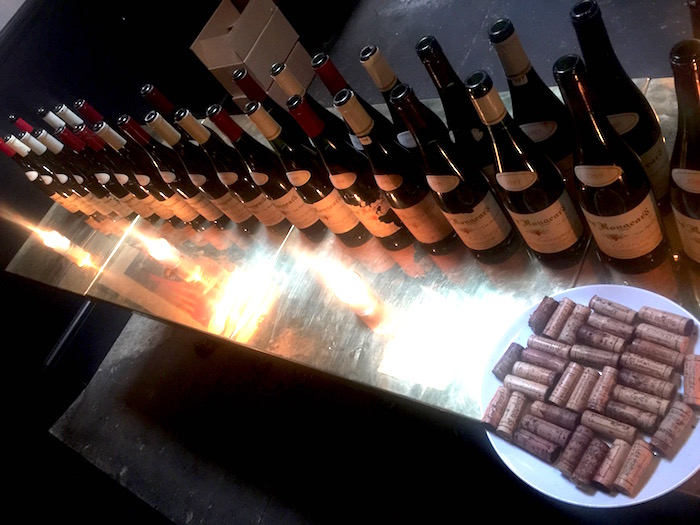
Clos Rougeard Saumur Blanc Brézé
|
1993 |
Fresh, fruited, green fig nose, faint oxidative hints, bright attack yet waxy textured, threaded acidity and exceptionally persistent. Super long. Ridiculously mouthwatering. Desert Island stuff, like a tuning fork in its intensity.
|
| Clos Rougeard Saumur Blanc Brézé |
2000 |
Perfume and camphor nose, rose petals, a dry vermouth-like spirity-ness. Herbal and the freshness builds with almost the same supreme length as 1993
|
Clos Rougeard Saumur Blanc Brézé
|
2005 |
Quince nose. Sandalwood and white flowers. Enormous intensity, primary, coiled. Give it 10 years
|
|
|
|
Clos Rougeard Saumur Saumur-Champigny 'Les Poyeux'
|
1976 |
Corky nose, damp cardboard, metallic palate at first. Jordi reckoned this wasn't corked. He was right, after an hour it had cleaned up, Still, the second bottle for the other table had creamy fruit, and was lovely. The only below par bottle of the night as it turned out on our table - so we can count ourselves lucky.
|
Clos Rougeard Saumur Saumur-Champigny 'Les Poyeux'
|
1985 |
Dusty nose but this has energy and a progression that is proper. Lovely finish. Overall a highly strung wine. Trying hard to present a beautiful public face but the age-lines are there. On its downward descent.
|
Clos Rougeard Saumur Saumur-Champigny 'Les Poyeux'
|
1986 |
Animal, leathery nose, bright, mouthwatering a little dry in the mid palate, over the other side of its plateau. Lovely mouthwatering finish nonetheless. I hour later just a touch spirity but a little more integrated and a touch of alcohol on the finish now the fruit is fading. Past its best.
|
Clos Rougeard Saumur Saumur-Champigny 'Les Poyeux'
|
1988 |
Great herbal nose, with an anis background and a touch of game. Ah, this is more like it. Lovely density and progression, fantastic energy and enormous length. This has lovely poise.
|
| Clos Rougeard Saumur Saumur-Champigny 'Le Bourg' |
1989 |
Darkly perfumed nose, a touch of cedar, warm entry, licorice and a little spice, and the spice is tangible too with a heady mid-palate. Very satisfying. Lifted, blackcurrant leaf finish. Long
|
| Clos Rougeard Saumur Saumur-Champigny 'Le Bourg' |
1990 |
Red fruits and cedar nose, enormous energy and brilliant finish. Great length and more of an expression of Bordeaux that any other of the night thus far.
|
Clos Rougeard Saumur Saumur-Champigny 'Les Poyeux'
|
1993 |
Pure nose, heady and spiced, redcurrenty undercurrent. Velvety palate, sweet, a little taste of heaven. Supremely integrated with an elegantly veined length.
|
Clos Rougeard Saumur Saumur-Champigny 'Les Poyeux'
|
1994 |
Extremely pure nose of licorice and peppercorn, so very gently sweet and svelte, so silken and smooth. The perfect sweetness. Strawberries on the finish and then a mouthwatering pithy finale.
|
Clos Rougeard Saumur Saumur-Champigny 'Le Bourg'
|
1995 |
Damp wool and perfumed nose. Sheep dipped in Joy par Jean Patou! On the palate the wine delivers a knock out punch. Not sweet, not dry. Aromatic. Sappy (in the best sense of the word) fresh finish. Such shape to the wine. Haute Couture, shaped like an hourglass.
|
| Clos Rougeard Saumur Saumur-Champigny 'Les Poyeux' |
1995 |
Nose of pure seduction. Silky and cedary, liquory texture thanks to melted tannins. Fully resolved. Rose infused mid-palate, intensity without weight, vibrant, heady finish
|
Clos Rougeard Saumur Saumur-Champigny 'Le Bourg'
|
1996 |
Crystalline nose. Alluring organic nose like sleeping next to someone. Burgundian weight. Dark flashes of fruit, interspersed with brighter notes, like shafts of light. Vibrant and heady length. Tonight's expression of Burgundy and what an expression! Warm finish but the warmth does not come from alcohol. Visceral. Perfection. Sherbetty profile on the finish. This went so well with the gorgeous lamb served by the Noble Rot team.
|
Clos Rougeard Saumur Saumur-Champigny 'Les Poyeux'
|
1999 |
Delicate nose, fabulous aromatics, striking palate. Delightful fruitiness and exuberance with the prickliness of acidity on the finish.
|
Clos Rougeard Saumur Saumur-Champigny 'Le Bourg'
|
2000 |
Wood box nose, whiff of varnish, deep warm attack. Huge. Needs a bit more time.
|
Clos Rougeard Saumur Saumur-Champigny 'Les Poyeux'
|
2002 |
Yeasty, bready nose, tight entry, citrus fruit, grapefruit, big flavours, boisterous wine. Lovely dry finish. Lots of concentration. Young. Will be one for the future. Tremendous potential.
|
Clos Rougeard Saumur Saumur-Champigny 'Le Bourg'
|
2005 |
Spiced nose, oranges and mulberries. The warmth of Bourg, liquory texture, like a dry version of Cointreau. The orange in there continues into the finish.
|
Clos Rougeard Saumur Saumur-Champigny 'Le Bourg'
|
2007 |
Creamy nose, preserved lemons and white pepper, like a lemon posset - creamy attack, sticky ripe fruit, yet sherbetty on the mid palate. Very, very long.
|
Clos Rougeard Saumur Saumur-Champigny 'Le Bourg'
|
2008 |
Potential writ large. Enormous concentration. Pithy, really pithy. Rapier like focus. All about the future. It's impossible to pin down, with at first a dark finish, then a bright finish. Amazing undercurrent of intense fruit.
|
Clos Rougeard Saumur Saumur-Champigny 'Les Poyeux'
|
2010 |
Round, ripe fruit. Fruity and yeasty. Intense fruit, on the terrific attack. Sticky lip-smacking fruit, fresh and plenty of potential. Great focus, like a corsetted wine. Extraordinary length
|
